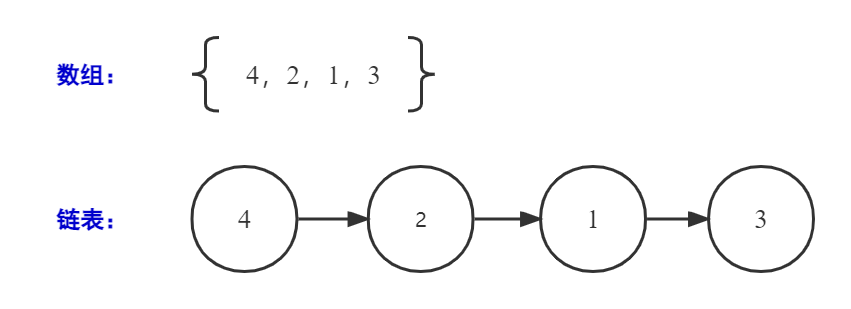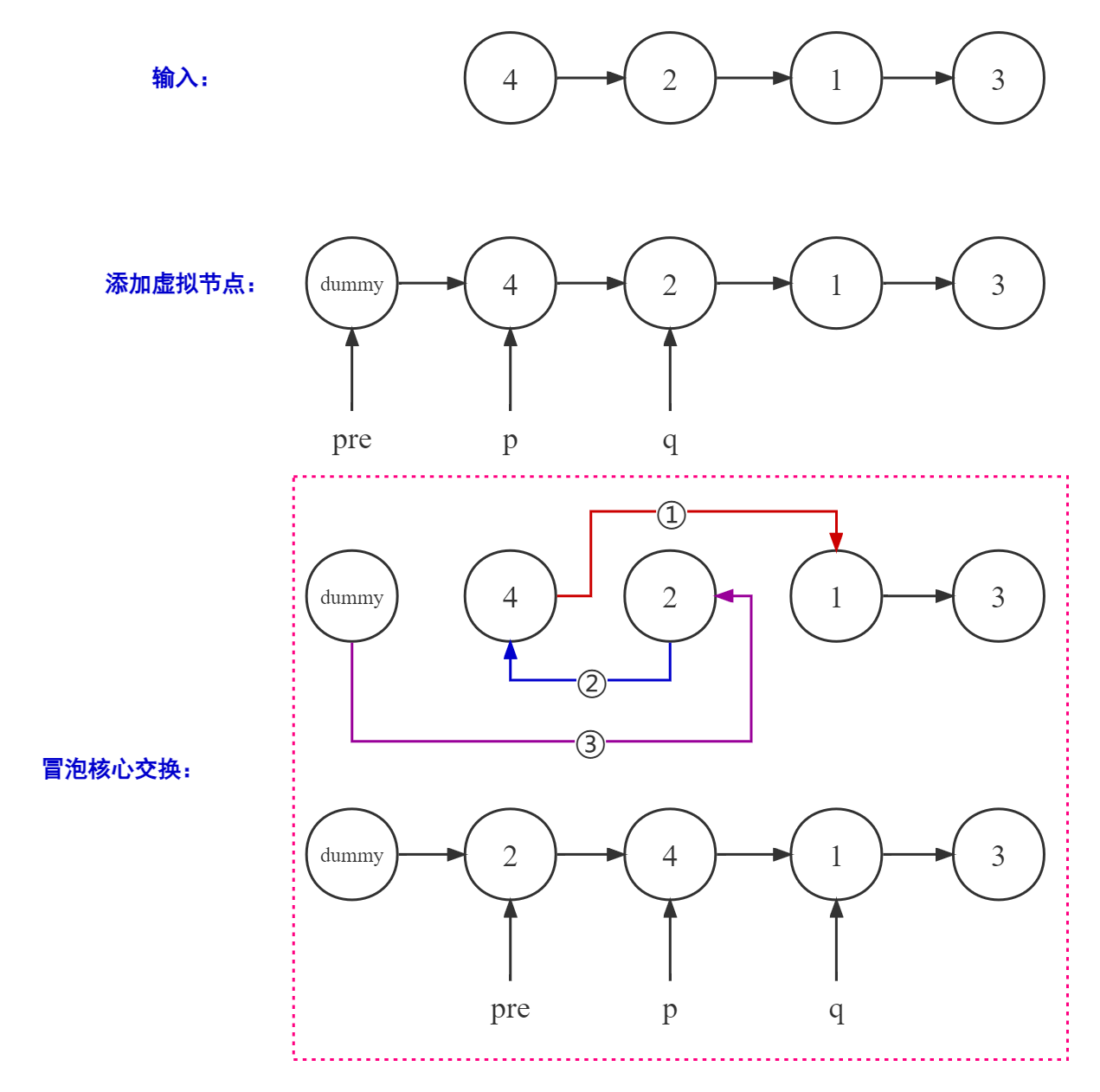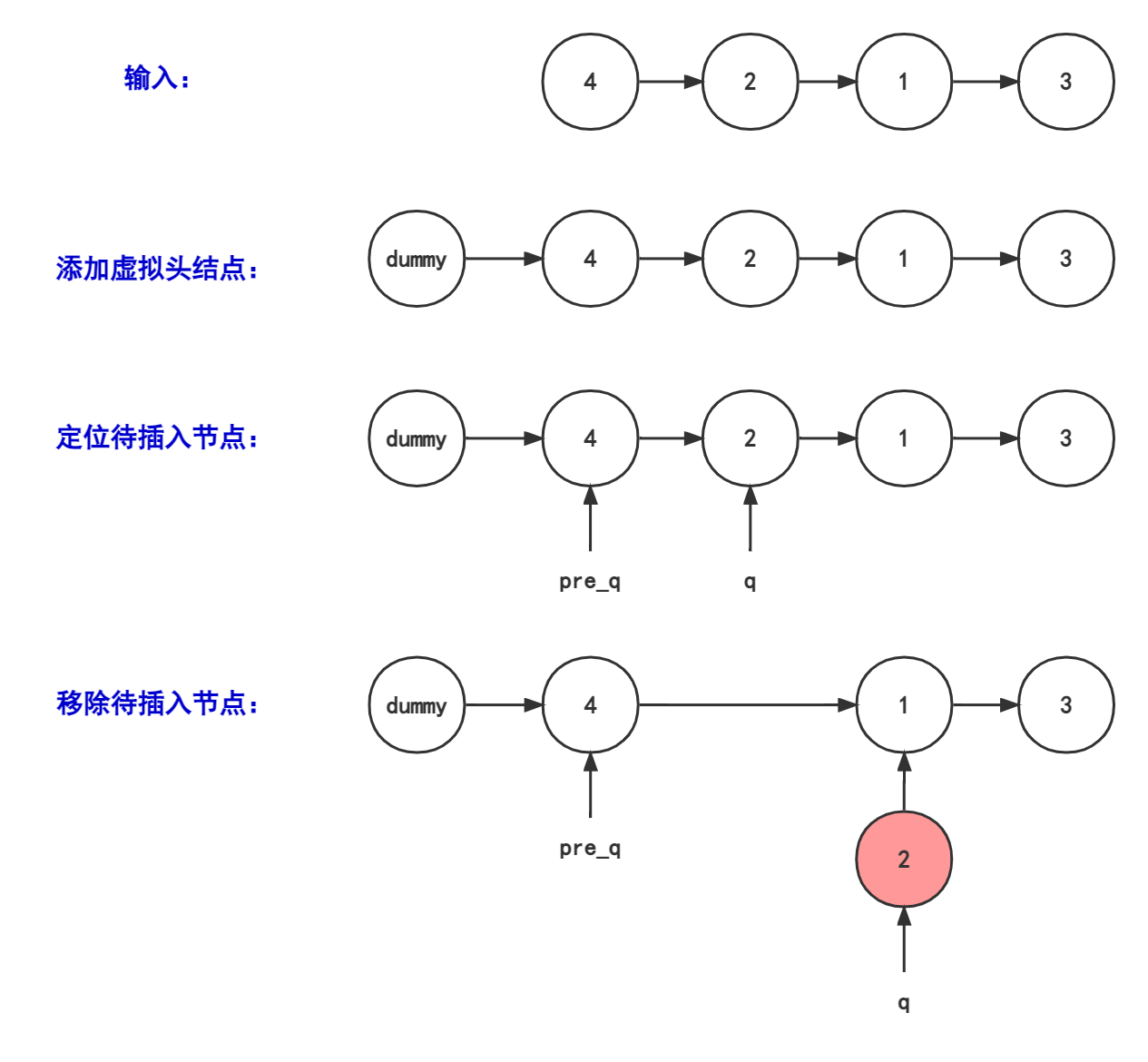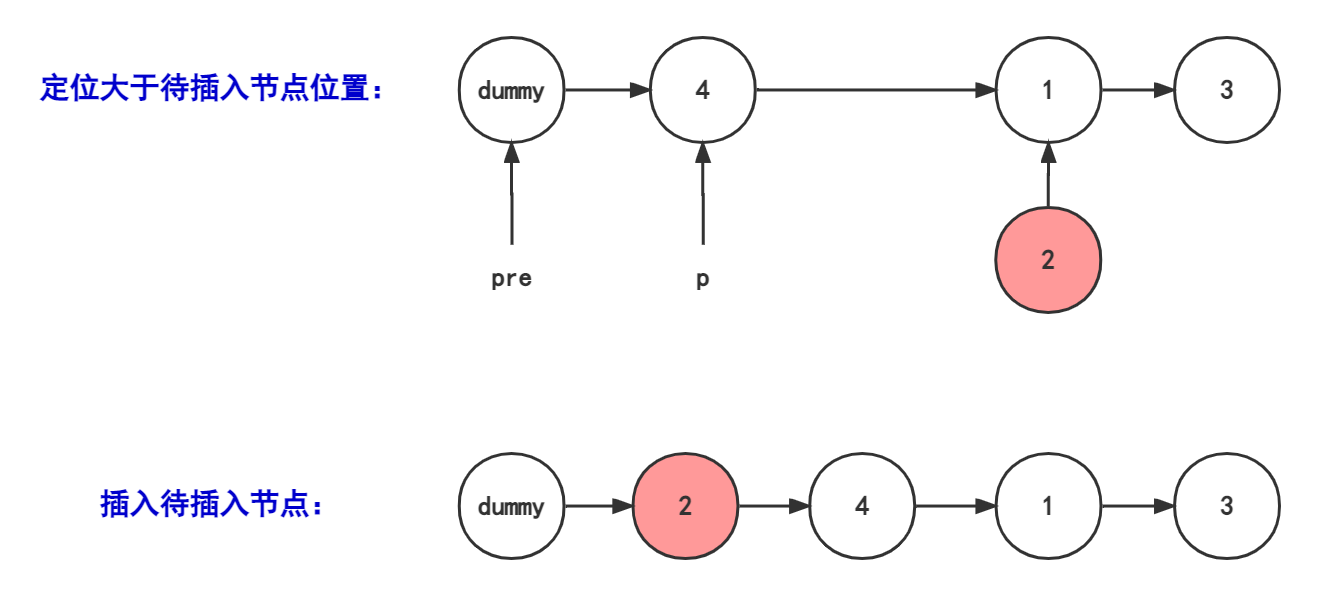
冒泡排序
算法核心:
相邻节点两两交换,重复进行(n-1)轮。
时间复杂度为
空间复杂度为
是否稳定:稳定
1.1 数组排序

图1 冒泡排序算法(数组)
public class BubbleSortArray {
public static void main(String[] args) {
BubbleSortArray sort = new BubbleSortArray();
sort.sortByBubble(new int[]{4, 2, 1, 3});
}
public void sortByBubble(int[] nums){
int n = nums.length; // 数组大小
for (int i = n-1; i > 0; i--) { // 循环n-1次
for (int j = 0; j < i; j++) {
if(nums[j] > nums[j+1]) { // 最大的值放最后,依次两两交换
int temp = nums[j];
nums[j] = nums[j+1];
nums[j+1] = temp;
}
}
}
// 输出结果
for (int i = 0; i < n; i++) {
if(i == n-1){
System.out.println(nums[i]);
continue;
}
System.out.print(nums[i]+"->");
}
}
}1.2 链表排序

图2 冒泡排序核心交换图
public class BubbleSortByLinkedList {
public static void main(String[] args) {
// 创建链表
ListNode head = new ListNode();
ListNode temp = new ListNode();
temp = head;
ListNode node4 = new ListNode(4);
temp.next = node4;
temp = temp.next;
ListNode node2 = new ListNode(2);
temp.next = node2;
temp = temp.next;
ListNode node1 = new ListNode(1);
temp.next = node1;
temp = temp.next;
ListNode node3 = new ListNode(3);
temp.next = node3;
temp = temp.next;
BubbleSortByLinkedList sort = new BubbleSortByLinkedList();
sort.sortByLinkedList(head.next);
}
public void sortByLinkedList(ListNode head){
ListNode dummy = new ListNode();
dummy.next = head;
ListNode temp = head;
int n = 0; // 统计链表节点个数
while (temp != null){
n++;
temp = temp.next;
}
for (int i = 0; i < n-1; i++) {
int num = n-i-1; // 统计内循环需要多少次
ListNode pre = dummy; // 最前一个节点
ListNode p = pre.next; // 第一个内循环节点
ListNode q = p.next; // 第二个内循环节点
for (int j = 0; j < num; j++) {
if(p.val > q.val){ // 前一个比后一个大,两两交换
p.next = q.next;
q.next = p;
pre.next = q;
}
// 下一次内循环指针指向
pre = pre.next;
p = pre.next;
q = p.next;
}
}
// 输出链表
dummy = dummy.next;
for (int i = 0; i < n; i++) {
if(i == n-1){
System.out.println(dummy.val);
continue;
}
System.out.print(dummy.val+"->");
dummy = dummy.next;
}
}
}
// 链表节点元素
class ListNode{
ListNode next;
int val;
ListNode(){}
ListNode(int val){
this.val = val;
}
}2. 插入排序
2.1 数组排序
算法核心:
首先,每一轮都假定待插入元素之前的数组元素是排好序的(算法也的确如此,没问题);
其次,找到大于待插入元素的下标;
紧接着,将待插入位置至待插入元素之前的上一个下标都后移一位;
最后,将待插入元素插入到找到的下标位置。
时间复杂度为
空间复杂度为
是否稳定:稳定

public class InsertSortByArray {
public static void main(String[] args) {
InsertSortByArray sort = new InsertSortByArray();
sort.sortByInsert(new int[]{4, 2, 1, 3});
}
public void sortByInsert(int[] nums){
// 统计数组元素个数
int n = nums.length;
for (int i = 1; i < n; i++) {
int insertNum = nums[i];
int j = 0;
while (j<i && nums[j] < insertNum){ // 寻找比插入元素大的下标
j++;
}
for (int k = i-1; k >= j; k--) { // 插入元素的后面元素都后移
nums[k+1] = nums[k];
}
nums[j] = insertNum; // 插入元素
}
// 输出结果
for (int i = 0; i < n; i++) {
if(i == n-1){
System.out.println(nums[i]);
continue;
}
System.out.print(nums[i]+"->");
}
}
}
2.2 链表排序
算法核心:
添加虚拟节点dummy,有利于找到修改节点的上一个节点,做移除操作。
接下来只需三步:
1. 定位待插入节点和待插入节点的前一个节点;
2. 定位大于待插入节点和大于待插入节点的前一个节点;
3. 移除待插入节点,将待插入节点插入到相应位置。


public class InsertByLinkedList {
public static void main(String[] args) {
// 创建链表
ListNode head = new ListNode();
ListNode temp = new ListNode();
temp = head;
ListNode node4 = new ListNode(4);
temp.next = node4;
temp = temp.next;
ListNode node2 = new ListNode(2);
temp.next = node2;
temp = temp.next;
ListNode node1 = new ListNode(1);
temp.next = node1;
temp = temp.next;
ListNode node3 = new ListNode(3);
temp.next = node3;
temp = temp.next;
InsertByLinkedList sort = new InsertByLinkedList();
sort.sortByLinkedList(head.next);
}
public void sortByLinkedList(ListNode head) {
// 统计链表节点个数
int n = 0;
ListNode temp = head;
while (temp != null){
n++;
temp = temp.next;
}
ListNode dummy = new ListNode();
dummy.next = head;
for (int i = 2; i <= n; i++) {
int j = 1;
ListNode pre = dummy; // 扫面链表节点的前一个节点
ListNode p = pre.next; // 扫描链表节点
ListNode pre_q = dummy; // 待插入节点的上一个节点
ListNode q = dummy.next; // 待插入节点
while (j < i){
j++;
pre_q = pre_q.next;
q = q.next;
}
pre_q.next = q.next; // 移除待插入节点
while (p != q && p.val <= q.val) { // 查找大于待插入节点的节点位置
pre = pre.next;
p = p.next;
}
// 插入待插入节点
q.next = p;
pre.next = q;
}
// 输出链表
dummy = dummy.next;
for (int i = 0; i < n; i++) {
if(i == n-1){
System.out.println(dummy.val);
continue;
}
System.out.print(dummy.val+"->");
dummy = dummy.next;
}
}
// 链表节点定义
static class ListNode{
ListNode next;
int val;
ListNode(){}
ListNode(int val){
this.val = val;
}
}
}






















 903
903

 被折叠的 条评论
为什么被折叠?
被折叠的 条评论
为什么被折叠?








